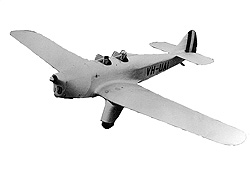In
July 1919 the International Commission for Air Navigation (ICAN) allocated civil
aircraft registration prefixes to each member nation. British Commonwealth countries
were allocated the letter 'G' with the next one or two letters indicating the
countries within the Commonwealth. England used 'G-E', New Zealand 'G-NZ', Canada
'G-CA' and Australia 'G-AU'.
Under the Air Navigation Act of 1920, Australia accepted responsibility for the "registration, marking and airworthiness" of aircraft. However, aircraft operating in Australia continued to be registered against the British nationality mark until 1929.
Australian Certificate of Registration No.1 was issued on 28 June 1921 for an Avro 504K aircraft. The registration allocated was G-AUBA.
A
number of other early 'out of sequence' registrations, for example G-AUJJ and
G-AUKH belonging to the Larkin organisation, were allocated following representations
about the cost of re-painting the aircraft. These aircraft were allocated an Australian
registration that permitted them to use the last two letters of their original
British registration.
With the exception of G-AUAA (see below), 'double letter' marks (e.g. G-AUBB) were not allocated, although the reason for this has not been established. Some other marks were also not allocated. From 1949 certain marks were listed as 'prohibited' for various reasons: for example, they conflicted with code groups used in wireless telegraphy, or they spelled 'dirty words' (e.g. _VD).
The first mark in the Australian series, G-AUAA, was allocated to CAB's new De Havilland DH37 which was registed on 1 July 1924, Certificate of Registration No. 98. CAB also reserved the block G-AUAA to G-AUAZ for its own use.
The International Radiotelegraph Convention in Washington, USA, in 1927 produced a revised table of Nationality and Registration markings for aircraft and other radio call-signs. These recommendations were duly adopted by ICAN in June 1928.
The Commonwealth of Australia was allocated the prefixes VH, VI, VJ, VK, VL and VM. Since the Dominions and Colonies did not have a vote at ICAN until about 1929, the allocation of 'VH' was probably made arbitrarily.
These prefixes were allocated as follows:
- VH - civil aircraft
- VI and VJ - Coastal Radio Stations, which communicated with ships at sea and, in the early days, with aircraft
- VK - Amateur Radio
- VL and VM - military aircraft post WWII
Within the group VH-A to VH-Z , certain blocks of letters were reserved for the RAAF, RAN and, later, for gliders.
From January 1929, Australian aircraft began displaying the nationality and registration mark 'VH'. Aircraft previously registered G-A__ dropped the 'G-A' prefix but retained the last three letters of their registration. Thus G-AUBA became VH-UBA. Because of the cost of re-painting aircraft, owners were given a period of twelve months in which to effect the change at the next major overhaul. An exception was aircraft flying overseas which had to change their markings before departing. Some owners stretched the twelve months grace period to the limit, with the last recorded changeover being made on 22 February 1933.
Click here to see the letter sent to Kingsford Smith and Ulm re the change of registration markings for the Southern Cross (G-AUSU/VH-USU)

From 1932
CAB Head Office (Melbourne) retained the last-letter registrations A,
B, C, X, Y and Z in each block (e.g. VH-BAA, VH-BAZ) and allocated the
remainder of marks in each block to the NSW Region, where most imported
aircraft were being assembled. In 1949 each Region (mainly based on
the various States) of the Department of Civil Aviation became responsible,
for the most part, for the allocation of blocks of markings within the
VH-B and subsequent blocks. The rule of allocating registrations in
alphabetical order was relaxed, allowing airlines and private owners
to obtain their company or personal initials for their aircraft registrations.
In 1967 DCA announced a new policy of 'lifetime registration' in order to prevent the confusion created by the practice of re-allocation of registrations and re-registration of aircraft. Although the policy had industry backing at the time, later pressure from industry caused the Department to abandon it and to resume re-registering aircraft and reallocating registrations. This has caused many problems for modern day researchers.
See also:
Sources:
This article was written by Roger Meyer and Phil Vabre and is based
on information from John Hopton and records in the archive of the Civil
Aviation Historical Society, including articles written by Geoff Goodall,
Tony Arbon, Bert Cookson (author of The Historic Civil Aircraft Register
of Australia), DCA Public Relations letters, and Aircraft magazine.
Back to the main Industry
Regulation and Aviation Policy index
Back to the main Flying Operations index
Back to the main Airworthiness index
If this page appears without a menu bar at top and left, click
here